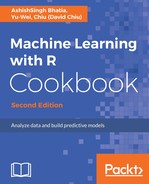Perform the following steps to display transactions and associations:
- First, you can obtain a LIST representation of the transaction data:
> LIST(trans)
Output
$Tr1
[1] "Apple" "Bread" "Cake"
$Tr2
[1] "Apple" "Bread" "Milk"
$Tr3
[1] "Bread" "Cake" "Milk"
- Next, you can use the summary function to show a summary of the statistics and details of the transactions:
> summary(trans)
Output
transactions as itemMatrix in sparse format with
3 rows (elements/itemsets/transactions) and
4 columns (items) and a density of 0.75
most frequent items:
Bread Apple Cake Milk (Other)
3 2 2 2 0
element (itemset/transaction) length distribution:
sizes
3
3
Min. 1st Qu. Median Mean 3rd Qu. Max.
3 3 3 3 3 3
includes extended item information - examples:
labels
1 Apple
2 Bread
3 Cake
includes extended transaction information - examples:
transactionID
1 Tr1
2 Tr2
3 Tr3
- You can then display transactions using the inspect function:
> inspect(trans)
Output
items transactionID
1 {Apple,
Bread,
Cake} Tr1
2 {Apple,
Bread,
Milk} Tr2
3 {Bread,
Cake,
Milk} Tr3
- In addition to this, you can filter the transactions by size:
> filter_trains = trans[size(trans) >=3]
> inspect(filter_trains)
Output
items transactionID
1 {Apple,
Bread,
Cake} Tr1
2 {Apple,
Bread,
Milk} Tr2
3 {Bread,
Cake,
Milk} Tr3
- Also, you can use the image function to visually inspect the transactions:
> image(trans)

Visual inspection of transactions
- To visually show the frequency/support bar plot, one can use itemFrequenctPlot:
> itemFrequencyPlot (trans)

Item frequency bar plot of transactions
